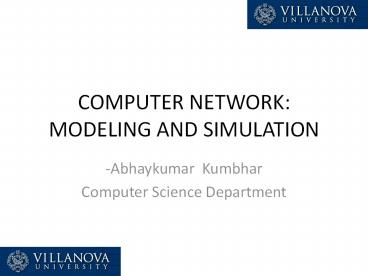COMPUTER NETWORK: MODELING AND SIMULATION - PowerPoint PPT Presentation
1 / 35
Title:
COMPUTER NETWORK: MODELING AND SIMULATION
Description:
COMPUTER NETWORK: MODELING AND SIMULATION-Abhaykumar Kumbhar Computer Science Department References: 1:Advanced Modelling and Simulation Methods for Communication ... – PowerPoint PPT presentation
Number of Views:689
Avg rating:3.0/5.0
Title: COMPUTER NETWORK: MODELING AND SIMULATION
1
COMPUTER NETWORKMODELING AND SIMULATION
- -Abhaykumar Kumbhar
- Computer Science Department
2
Motivation
- Bridge between Real life application and
Theoretical world.
3
Contents
- Introduction.
- Modeling.
- Simulation.
- How to develop a Model.
- Classification .
- NS simulator.
- OPNET.
- An Ethernet Case Study.
- Requirements of a good Network Simulating Tool
- Evolution.
- Conclusion and Future Work
4
Introduction
- Performance analysis of computer networks
increase in size and geographical extent. - The size of the networks and the inherent
complexity of network protocols complicate this
analysis. - Analysis techniques such as queuing models have
difficulty modeling dynamic behavior
retransmission timeouts and congestion. - Simulation offers a better method of studying
computer networks, since one can simulate the
details of actual protocols.
5
- Simulation is an analysis and evaluation tool.
- Every simulation is tight to a model that
represents the real world. - Inconsistent modeling
- Modeling itself is a crucial step towards
meaningful results. - Aim systematic modeling techniques -increase the
quality and validity of results
6
Modeling
- Constructing a conceptual framework that
describes a system.
7
Modeling Taxonomy
8
Simulation
system boundary
system under study (has deterministic rules
governing its behavior)
exogenous inputs to system (the environment)
real life
observer
9
Why Simulation?
- study system performance, operation
- real-system not available, is complex/costly or
dangerous (eg space simulations, flight
simulations) - quickly evaluate design alternatives (eg
different system configurations) - evaluate complex functions for which closed form
formulas or numerical techniques not available
10
When to Use Simulation?
- Whenever Mathematical Analysis Is Difficult or
Impossible. - For Validating Analytic Models.
- For Experimentation Without Disturbing an
Operational System
11
How to develop a model
- Determine the goals and objectives
- Build a conceptual model
- Convert into a specification model
- Convert into a computational model
- Verify
- Validate
12
(No Transcript)
13
Simulation Model Development Methodology
14
Simulation Model Verification and Validation
15
Classification of Simulation Tools
- GPPL General Purpose Programming Language
- PSL Plain Simulation Language
- SP Simulation Package
16
NS Simulator
- Began as REAL in 1989
- Developed by UC Berkeley
- Public domain SP
- Object-oriented
- Written in C and object-oriented tcl (Otcl)
- Network components are represented by classes
17
Ns class hierarchy
18
OPNET
- Developed by OPNET Technologies Inc.
- Commercial SP
- Object-oriented
- Totally menu-driven package
- Built-in model libraries contain most popular
protocols and applications - Simulation task made easy
19
Modeling hierarchy in OPNET
20
(No Transcript)
21
An Ethernet Case Study
- Bridging the Gap Between Reality and Simulations
- We set up our test-bed using two nodes connected
by a 3 meter cross-over Ethernet cable. - a simple test-bed experiment and attempt to
replicate the obtained results by simulation in
ns-2,QualNet and OPNET.
22
- Network details
- set packet size of the application to 1472 bytes.
This was to ensure that the maximum Ethernet
frame of 1500 bytes would be transmitted
23
Delay experienced by packets in saturated case
with non-blocking sockets
- particularly interested in the saturation
performance of the system and we chose multiple
rates near the maximum link bandwidth
24
- The maximum delay of the system is experienced
when the source bufferis full. - This delay is given as max delay tx delay
buffer size in packets. - The transmission delay for one packet is the
minimum delay. - The buffer size is then calculated as max
delay/min delay. Hence a buffer size of 78
packets was arrived at 94/1.2 78packets
128KB.
25
- Setting up simulations in QualNet
- --the link propagation delay being negligible,
set it to 25 µs to model test-bed network
characteristics. - --queue size from its default value of 50 KB to
117 KB, which corresponds to 78 packets of 1500
bytes each.
26
- Setting up simulations in OPNET
- Ethernet Station Advanced (ESA).
- The ESA has a traffic generator built over the
Ethernet MAC. - the queue length to infinity.
- OPNET models queues as a set of sub-queues,
allowing the possibility of different
application traffic to map on to different
queues. By default only one sub-queue is created
in the Ethernet MAC process model and this is a
hidden parameter. This sub queue is accessed as a
process interface of the Ethernet MAC process
model. The sub-queue packet capacity was set to
78 packets.
27
- Setting up simulations in NS-2
- configurable parameters node objects, link
bandwidth, maximum length and type of the
interface queue and delay. - queue length to 78.
- maximum propagation delay is 25 µs for 10 Mbps.
28
- Results
- Figure Throughput
29
- Figure Packet Delivery Fraction
30
- Figure Average End-to-End Delay
31
Requirements for Network Simulation tools
- Model development simplicity
- Modeling flexibility
- Fast modeling
- Animation
- Different kinds of implemented components
- Component adaptability
- Creating new components
- Static capabilities of a simulator
- Graphs
32
Evolution of Network Simulation Tools
- Zeroth Generation General Purpose Languages
- - Fortran, C/C, Pascal, Basic
- First Generation General Purpose Queueing
System Simulations - -GPSS, SLAM, SIMSCRIPT
- Second Generation Application Specific
Computer Systems and Wide-Area Communication
Networks - Third Generation Integration of Second
Generation Languages - -With a Graphics-Oriented Analysis and Modeling
Environment - -SES/Workbench
- -OPNET
33
Conclusion and Future work
- Best way to learn Protocols.
34
References
- 1Advanced Modelling and Simulation Methods
- for Communication Networks Jože Mohorko, Fras
Matjaž, Klampfer Saša. - 2www.sciencedirect.com
- 3www.ieeexplore.org
35
- THANK YOU
- QUESTIONS??































